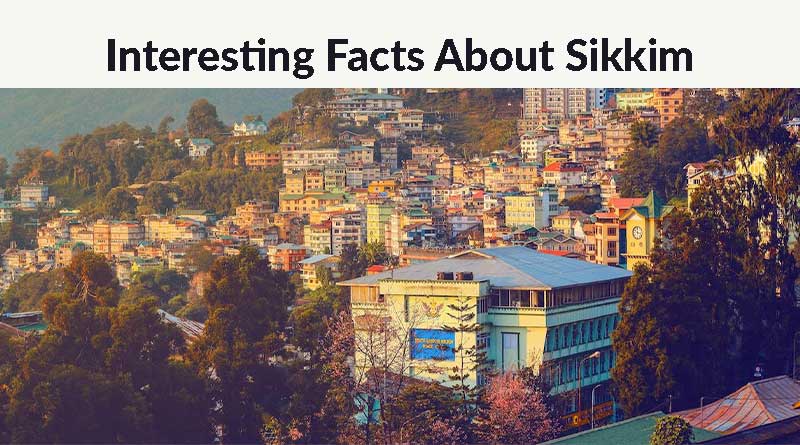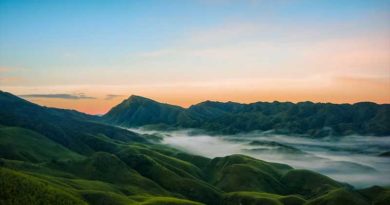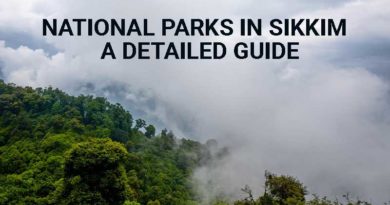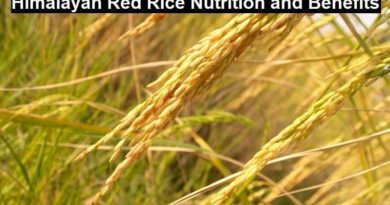12 Interesting Facts About Sikkim You Did Not Know
Sikkim is truly a paradise on earth. This hidden gem lives at the edge of northeastern India among the Himalayan mountains. Whether you’re looking for majestic nature, rich culture, fascinating art, or immense hospitality, you’ll find it there.
The state is known for its eco-friendly initiatives and for being one of the most peaceful states in India. It is the perfect place to visit for relaxation, meditation, and refilling your energy.
In this article, we’ll list down some of the most interesting facts about Sikkim. So, read on to learn more!
Where Is Sikkim?
Sikkim is a state in northeastern India that is bordered by Nepal, China, and Bhutan. It’s known for its amazing landscapes, glaciers, mountains, alpine meadows, wildflowers, and more. The nature in Sikkim is truly one of a kind.
The state is praised globally for its government policies and initiatives. It is one of the cleanest states in India and the first in the world to be 100% organic. Moreover, according to the World Book of Records London, it is a crime-free state.
The main source of income in Sikkim is agriculture since the majority of the population work in this business. Some of the main crops in the state include cardamom, ginger, tea, tomato, potato, rice, and more.
Another major contributor to the economy of Sikkim is handicrafts. The fascinating nature of Sikkim has fostered a love of art among its people. Their mastery of the craft has allowed them to earn a living and attract tourists from all over the world to buy these products.
Here’s an article about the Complete Guide about Sikkim: Traditional Games, Dance, and Food
Interesting Facts About Sikkim
This small state with a rich heritage has a lot of interesting facts. Let’s explore some of them!
1. Sikkim Is the Least Populated State in India
With around 671 thousand people living in Sikkim, it is the least populated state in India. Despite this small population, the state embraces different religions and ethnic groups, and all of them are living in peace and harmony.
It is also the second smallest state in India after Goa.
2. The World’s Third-Highest Peak Lives in Sikkim
Kanchenjunga, or as the people of Sikkim call it “Sleeping Buddha Mountain,” is the third-highest peak in the world. It has an altitude of 8,586 m and is located in the eastern Himalayas between Sikkim and Nepal. It is also the highest peak in India.
This majestic mountain is a sight to behold. It looks breathtaking from numerous viewpoints and you should visit it at least once in your lifetime. Moreover, this mountain is even sacred to the locals!
3. Lake Tsogmo has an Interesting Legend
Lake Tsogmo is located in eastern Sikkim and it is assumed that a lot of tribal people used to live around it. The legend once said there was an old lady who had a prophecy that the water of the lake would soon submerge the entire place, leaving nothing alive behind.
The people living around the lake did not believe her and moved on with their lives no matter how much she tried to convince them. She repeated her attempts to make them listen but failed.
Two weeks later, the water of the lake swallowed the whole place and killed everyone, even the animals.
To this day, the natives of Sikkim still go to Lake Tsogmo to pray for the dead.
4. Prayer Flags Are All Around Sikkim
You can find prayer flags all around Sikkim. The locals use them to bless the surroundings and bring goodwill and compassion to every living soul. These cotton pieces are hung outside because it is believed that the wind will carry their spiritual message to the world.
They come in 5 colors and each one symbolizes a different element. Yellow represents Earth, green represents water, red represents fire, white represents the wind, and blue represents the sky. The locals believe that harmony and health can be achieved if these 5 elements are balanced.
You can find them hung on poles at monasteries, temples, and mountains. They can even find prayer flags on Mount Everest. As they are sacred items, they’re supposed to be burnt when they get old out of respect so they don’t get mistreated.
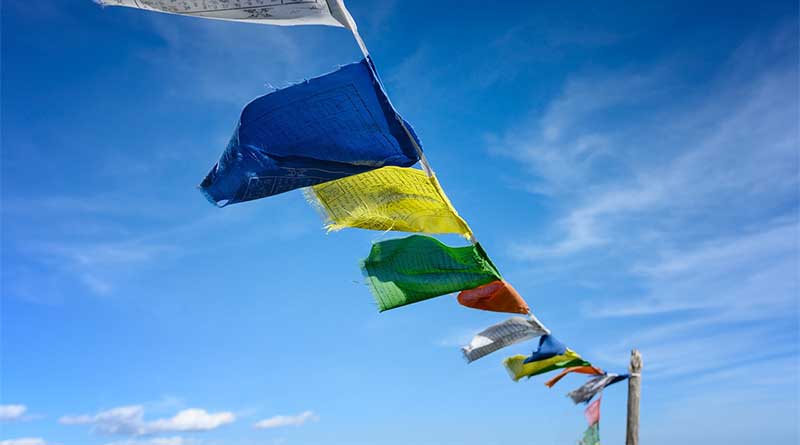
5. Sikkim Is India’s Largest Producer of Cardamom
Sikkim is the world’s second-largest producer of large cardamom and India’s largest producer. This crop is an essential part of the economy of the small state.
In fact, 15% of the population of Sikkim participates in the production of cardamom. In the last few years, the state has produced more than 5000 tonnes of large cardamom. To expand its profits even further, Sikkim is researching new ways to make mats using cardamom.
It is believed that the Lepchas domesticated cardamom centuries ago, but the details of its origins are unclear.
6. Sikkim Is India’s Glacier Hotspot
With 84 glaciers, Sikkim has more glaciers than any other state in India. Out of all these glaciers, Zemu Glacier is the largest one as it spreads over 26 km.
The glaciers of Sikkim used to resist the impact of global warming as the state is surrounded and landlocked by mountains on all sides. However, studies have found that 23 glaciers in Sikkim have been affected by global warming in the last 3 decades. This is a warning for all of us to start taking action before it’s too late.
7. Highest Lakes in India Live in Sikkim
Sikkim is home to Lake Gurudongmar and Lake Cholamu, which are the highest lakes in India. These two lakes are located at a dazzling altitude of almost 18000 feet from sea level.
What is a better view than a lake on top of the world surrounded by snow-capped mountains? The serenity of the place can purify your soul and it is certainly an experience you will never forget.
8. One of the Hottest Chilies Belongs to Sikkim
As if Indian food is not spicy enough – Dalle Khursani is one of the hottest chilies in the world and it is grown in Sikkim. Dalle Khursani is used to make pickles which are sold in India and even exported overseas.
9. Sikkim Is the World’s First 100% Organic State
According to the World Book of Records London, Sikkim is the first 100% organic state in the world. Knowing the unpleasant effect of chemical pesticides and fertilizers on the environment, Sikkim has implemented a 100% organic policy for all of its crops.
Around 75000 hectares of land in Sikkim became organic by using organic fertilizers and pesticides instead of chemical ones. To implement this policy, the state has set a punishment of 3 months in prison and a fine of 1 lakh for any individual that violates this law.
Due to their exceptional care for the environment, the United Nations has granted Sikkim the “Oscar Award for Best Policies.”
10. Sikkim Is Bordered by 3 Countries
Sikkim is one of the very few Indian states that share borders with 3 countries. It is bordered by Nepal in the west, China in the north, and Bhutan in the east. That’s why Sikkim is blessed with a unique mixture of different cultures, religions, and traditions – and all of them live in harmony in this crime-free state.
11. Half of Sikkim Is Covered With Forests
More than 47% of Sikkim’s land is covered with forests. Half of this forest cover belongs to Khangchendzonga National Park, which is a UNESCO World Heritage site. Khangchendzonga National Park holds a third of India’s flowering plants and almost half of the country’s bird diversity and rhododendrons.
12. Teesta River Is Born in Sikkim
Teesta River, which runs through India and Bangladesh, originates from the Zemu glacier in Sikkim. It is also one of the largest rivers that feed into the Brahmaputra River, which is an important river for transportation and irrigation in the region.
What to Do in Sikkim?
After learning the interesting facts about Sikkim, let’s explore some of the best activities you can do when you visit!
1. Walk in the Valley of Flowers
The Valley of Flowers is located in Yumthang at an altitude of 11800 ft. No matter which season you visit in, except for Winter, the valley will be covered with flowers. What’s even more impressive is that the type of followers changes depending on the season, so you can have a different experience every time you visit.
Price: Free
2. Get Soaked in a Hot Spring
Hot springs are hidden gems in Sikkim that not many people are aware of. The most popular one is the Reshi Hot Spring due to its religious importance and its accessible location in Yumthang.
The Reshi Hot Spring is believed to have medicinal properties. Visitors and pilgrims enjoy soaking themselves in its therapeutic waters while looking at the breathtaking surroundings. So bring your towel and experience this natural spa!
Price: Free
3. Experience Mountain Biking Through the Himalayas
If you visit Sikkim, then taking a mountain biking tour should definitely be on top of your to-do list. It is one of the most popular activities among tourists. Bike through the Himalayas on some of the most dramatic and thrilling terrains.
The thrill of the biking trail along with the view of the snow-capped mountains will make you awestruck!
Price: 100 – 1000 INR
4. Bathe Under the Bakthang Waterfalls
You cannot visit Sikkim without bathing under the Bakthang Waterfalls. It is one of the most beautiful places in Sikkim with greenery surrounding you and water falling down the mountain to complement the breathtaking view.
One of the first things you will notice about the Bakthang Waterfalls is their width. They are so wide and flow their water into a small pool.
If you don’t want to bathe under the waterfall, you can also watch this beauty from a footbridge right in front of it. For the adventurous ones, you can do ziplining across the waterfall as well!
Price: Free
5. Watch Sikkim From a Helicopter
The nature of Sikkim is unmatched – so how about watching all of its beauty from a helicopter? You will get to see all the mountains, valleys, forests, waterfalls, the Teesta River, and more from the sky. It is a unique experience that you shouldn’t miss!
Price: 18000 – 9000 INR
6. Take the Gondola Ride
The Gondola ride is something you should do if you visit Gangtok. Get in the cable car and watch the capital of Sikkim, its humble buildings, forests, and the gorgeous landscape in the background while being mid-air.
It is one of the most exciting experiences you can have in Sikkim and it is suitable for all ages.
Price: 70 – 110 INR
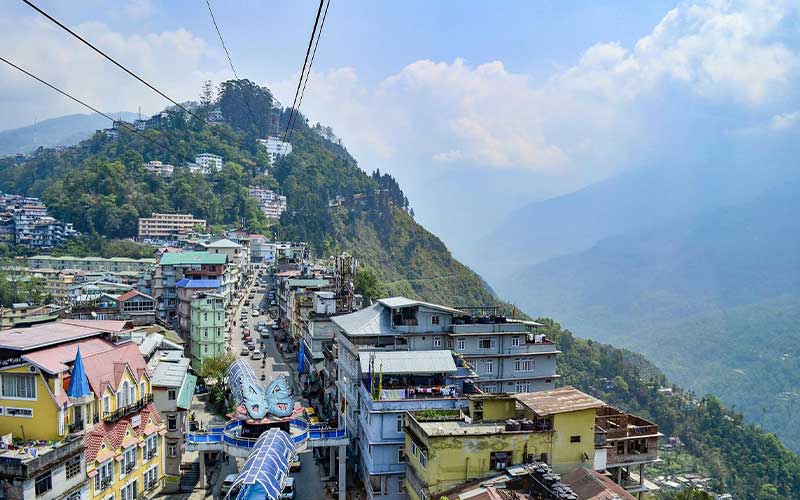
7. Go Handicrafts Shopping
Shopping for handicrafts in Sikkim is something you should definitely consider when you visit. They have some of the best handicrafts in the world that are highly detailed, elegant, and of premium quality. The locals train for years to learn the needed skills and qualify for making handicrafts that meet the standards of the state.
Some of the handicrafts that you can buy are wooden masks, thangkas, carpets, furniture, handlooms, and more. You can find them at local shops or monasteries and temples.
Whether you want to buy or just appreciate looking at these handicrafts, The Directorate of Handicrafts and Handloom is one of the best places to visit. It’s a reservoir for any type of handicrafts that you need.
Check an ultimate list of Traditional Handicrafts of Sikkim: www.ourhimalayas.com/7-beautiful-traditional-handicrafts-of-sikkim
Price: Depends on which item you buy.
8. Meet the Locals
You shouldn’t miss out on meeting the locals when you visit Sikkim. The locals are very friendly and welcoming and their hospitality is heart-warming. So, take the time to meet them and learn about their culture and history. They will even welcome you to their homes and cook their best local dishes for you.
Price: Free – but it would be great if you brought a small gift to show your appreciation.
Final Thoughts
Sikkim is one of the best places you could visit to relax and enjoy the unspoiled nature. It is home to breathtaking landscapes, majestic mountains, beautiful valleys, and much more. We hope that the mesmerizing facts we mentioned have inspired you to visit Sikkim one day!
